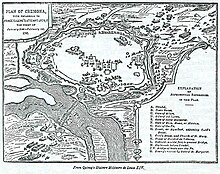Battle of Cremona
| Battle of Cremona | |||||||
|---|---|---|---|---|---|---|---|
| Part of the War of the Spanish Succession | |||||||
 Battle of Cremona | |||||||
| |||||||
| Belligerents | |||||||
|
Danish Auxiliary Corps |
| ||||||
| Commanders and leaders | |||||||
|
Prince Eugene Prince de Vaudémont |
duc de Villeroi | ||||||
| Casualties and losses | |||||||
|
800 killed and wounded[1] 400 captured |
1,200 killed and wounded[1] 300 captured | ||||||
The Battle of Cremona took place on the night of 31 January to 1 February 1702, during the
Background
The Duchies of
Battle
Eugene had a contact inside Cremona, a priest named Cuzzoli; on the night of 31 January 1702, he admitted a party of Imperial grenadiers by means of a hidden culvert and they seized control of the St Margaret Gate.
A second and larger force under
Aftermath
The two Irish units lost an estimated 350 out of 600 men engaged; their commander Major Daniel O'Mahoney was later presented to Louis XIV and knighted by the Stuart exile James III. He went on to have a distinguished career, fighting in Spain and Sicily; he ended as a Lieutenant-General and died in Ocaña, Spain in 1714.[3]
Villeroi was soon released but his capture commemorated in verse; Par la faveur de Bellone, et par un bonheur sans égal, nous avons conservé Crémone et perdu notre général. (By the favour of Bellone, and a happiness without equal, we saved Crémone and lost our general).
The battle was also commemorated as a march entitled 'The Battle of Cremona' later used in the Irish Brigade.[4]
Notes
- ^ a b Bodart 1908, p. 125.
- ISBN 978-1856356626.
- ISBN 978-1856356626.
- ^ "The Battle of Cremona". The Traditional Tune Archive. Retrieved 17 April 2018.
References
- Bodart, Gaston (1908). Militär-historisches Kriegs-Lexikon (1618–1905). Retrieved 4 February 2023.
Further reading
- Eggenberger, David (1967). A Dictionary of Battles. New York: Thomas Y. Crowell. p. 110.
{{cite encyclopedia}}: Missing or empty|title=(help)
